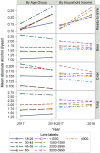Changes in alcohol purchases from grocery stores after authorising the sale of stronger beverages: The case of the Finnish alcohol legislation reform in 2018
- PMID: 36452445
- PMCID: PMC9703366
- DOI: 10.1177/14550725221082364
Changes in alcohol purchases from grocery stores after authorising the sale of stronger beverages: The case of the Finnish alcohol legislation reform in 2018
Abstract
Aims: The Finnish alcohol law was reformed in January 2018. The availability of alcoholic beverages in grocery stores increased as the legal limit for retail sales of alcoholic drinks was raised from 4.7% to 5.5% alcohol, and the requirement of production by fermentation was abolished. We analysed how the inclusion of strong beers, ciders, and ready-to-drink beverages in grocery stores was reflected in alcohol purchases, and how these changes differed by age, sex, level of education and household income. Design: The study sample included 47,066 loyalty card holders from the largest food retailer in Finland. The data consisted of longitudinal, individual-level information on alcohol purchases from grocery stores, covering the time period between 1 January 2017 and 31 December 2018. The volumes of absolute alcohol during a calendar year from beers, ciders, ready-to-drink beverages, and in total, were calculated. Alcohol purchases in 2017 and 2018 were compared. Results: There was no overall change in the total alcohol (0.04 [95% CI -0.03, 0.11] litres/year) or beer purchases (-0.05 [95% CI -0.11, 0.02] litres/year). Purchases of ready-to-drink beverages increased by 0.10 [95% CI 0.09, 0.11] litres/year (+ 84%). Total alcohol purchases increased in the three highest income groups, whereas they decreased in the two lowest groups (p for the interaction < 0.0001). Conclusions: The increased purchases of alcohol as ready-to-drink beverages were, on the average, compensated for by a decrease in purchases of other alcoholic beverages. Higher prices probably limited the purchases among lower income groups and younger consumers, while the increase was sharper in higher income groups.
Keywords: availability; beer; loyalty card data; price; ready-to-drink beverage; socio-demographic groups.
© The Author(s) 2022.
Conflict of interest statement
The authors declared the following potential conflicts of interest with respect to the research, authorship, and/or publication of this article: Mikael Fogelholm is a member of the S-group Advisory Board for Societal responsibility. The membership is without any compensation. The other contributors declared no conflict.
Figures



Similar articles
-
Who buys non-alcoholic beer in Finland? Sociodemographic characteristics and associations with regular beer purchases.Int J Drug Policy. 2023 Mar;113:103962. doi: 10.1016/j.drugpo.2023.103962. Epub 2023 Feb 4. Int J Drug Policy. 2023. PMID: 36746032
-
Alcohol expenditure in grocery stores and their associations with tobacco and food expenditures.BMC Public Health. 2019 Jun 20;19(1):787. doi: 10.1186/s12889-019-7096-3. BMC Public Health. 2019. PMID: 31221122 Free PMC article.
-
Impact of price promotion, price, and minimum unit price on household purchases of low and no alcohol beers and ciders: Descriptive analyses and interrupted time series analysis of purchase data from 70, 303 British households, 2015-2018 and first half of 2020.Soc Sci Med. 2021 Feb;270:113690. doi: 10.1016/j.socscimed.2021.113690. Epub 2021 Jan 9. Soc Sci Med. 2021. PMID: 33461035
-
Production, Consumption, and Potential Public Health Impact of Low- and No-Alcohol Products: Results of a Scoping Review.Nutrients. 2021 Sep 10;13(9):3153. doi: 10.3390/nu13093153. Nutrients. 2021. PMID: 34579030 Free PMC article.
-
Convenience Stores: Source of Food/Beverages among Children: What We Eat in America, NHANES 2015-2018.2021 Sep. In: FSRG Dietary Data Briefs [Internet]. Beltsville (MD): United States Department of Agriculture (USDA); 2010–. Dietary Data Brief No. 42. 2021 Sep. In: FSRG Dietary Data Briefs [Internet]. Beltsville (MD): United States Department of Agriculture (USDA); 2010–. Dietary Data Brief No. 42. PMID: 36630551 Free Books & Documents. Review.
Cited by
-
Shopping Data for Population Health Surveillance: Opportunities, Challenges, and Future Directions.J Med Internet Res. 2025 Aug 6;27:e75720. doi: 10.2196/75720. J Med Internet Res. 2025. PMID: 40769214 Free PMC article.
-
Habits, consumption and public control.Nordisk Alkohol Nark. 2022 Dec;39(6):587-588. doi: 10.1177/14550725221136364. Epub 2022 Nov 23. Nordisk Alkohol Nark. 2022. PMID: 36452442 Free PMC article. No abstract available.
-
Assessing the early influence of COVID-19 in an analysis of the immediate implementation of Minimum Pricing for Alcohol on drinkers in Wales.Nordisk Alkohol Nark. 2024 Feb;41(1):57-74. doi: 10.1177/14550725231202066. Epub 2023 Oct 3. Nordisk Alkohol Nark. 2024. PMID: 38356791 Free PMC article.
References
-
- Alcohol Act 1344/1994. Finlex data bank. https://www.finlex.fi/fi/laki/alkup/1994/19941344
-
- Babor T., Caetano R., Casswell S., Edwards G., Giesbrecht N., Graham K., Grube J., Gruenewald P., Hill L., Holder H., Österberg E., Rehm J., Room R.,, Rossow I. (2003). Alcohol: No ordinary commodity. Research and public policy. Oxford University Press.
-
- Bruun K., Edwards G., Lumio M., Mäkelä K., Pan L., Popham R. E., Room R., Schmidt W., Skog O.-J., Sulkunen P.,, Österberg E. (1975). Alcohol control policies in public health perspective. The Finnish Foundation for Alcohol Studies.
LinkOut - more resources
Full Text Sources
